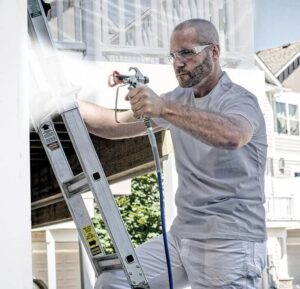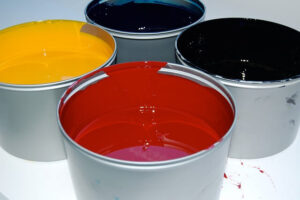What is an airless paint sprayer?

An airless paint sprayer is a tool that uses high pressure to atomize paint, delivering a smooth, even coat without compressed air. It’s ideal for large projects like house exteriors or detailed work like cabinets, offering speed and quality. Popular among professionals and DIYers, it requires practice for best results.
No air is used, hence the name Airless Paint Sprayer.
Table of Contents
- What types of paints can be used in an airless paint sprayer?
- What are the benefits of using an airless paint sprayer?
- How Does an Airless Paint Sprayer Improve Efficiency?
- Why Does an Airless Paint Sprayer Ensure Consistency?
- How Can an Airless Paint Sprayer Reduce Labor?
- How Does an Airless Paint Sprayer Enhance Paint Quality?
- Why Is an Airless Paint Sprayer Versatile for Different Projects?
- How Does an Airless Paint Sprayer Offer Increased Control?
- How Can an Airless Paint Sprayer Minimize Paint Waste?
- What Are the Health Benefits of Using an Airless Paint Sprayer?
- What are airless paint sprayer applications?
- Can You Paint Walls with an Airless Paint Sprayer?
- Is an Airless Paint Sprayer Suitable for Ceilings?
- How Can an Airless Paint Sprayer Be Used for Cabinets?
- Can You Use an Airless Paint Sprayer for Furniture?
- Is an Airless Paint Sprayer Ideal for Decks and Fences?
- Can Vehicles and Metal Constructions Be Painted with an Airless Paint Sprayer?
- Can you paint a car with an airless sprayer?
- What Are the Different Types of Airless Paint Sprayers?
- What cleaner should I use to clean my airless sprayer?
- What Should You Know About Airless Paint Sprayers Before Buying?
- Pros and Cons
- Conclusion
- FAQ
Key Points
-
High-pressure system: Uses a pump to spray paint at 1,000 to 7,000 psi, creating a fine mist (Higher pressures are needed for thick coatings).
-
Versatile: Handles various paints, from stains to thick latex, without thinning.
-
Efficient: Speeds up painting compared to brushes or rollers.
-
Learning curve: Requires proper setup and technique to avoid overspray or clogs.
How It Works
A high-pressure pump forces paint through a small tip, breaking it into a fine mist of paint droplets. This allows for a more efficient and effective application of paint, as it can cover a large area quickly and evenly without the risk of drips and runs that can occur with traditional brushing or rolling methods.
To function effectively, the sprayers require a pressure of between 1,000 and 5,000 PSI (pounds per square inch). The exact pressure required will depend on the spray tip’s size, the type of paint used, and the surface being painted. Due to the high pressure, the sprayer produces lots of overspray.
For example, the Graco Ultra 395 is a 3300 psi airless paint sprayer. Most airless handheld sprayers operate between 1500 and 2000 psi.
Why Choose an Airless Sprayer?
It’s faster than traditional methods and provides a professional finish, especially for large or intricate surfaces. However, due to the high pressure, users must follow safety guidelines, like wearing protective gear.
What types of paints can be used in an airless paint sprayer?
Airless paint sprayers are commonly used for interior and exterior painting projects and for applying various materials, such as latex paint, Oil-based paint, stains, sealers, and lacquers.
Can You Use Latex Paint in an Airless Paint Sprayer?
Latex paint, a water-based option, works well with airless sprayers. Use a medium tip (0.015–0.017 inches) for even coverage. It’s easy to clean with water, ideal for walls and ceilings.
Is Oil-Based Paint Suitable for Airless Paint Sprayers?

Oil-based paints, known for durability, are suitable but may need a larger tip (0.017–0.019 inches) and thinning if too thick. Cleaning requires mineral spirits, which demand proper ventilation.
Are Stains Compatible with Airless Paint Sprayers?
Stains, used for wood surfaces like decks, are compatible. Smaller tips (0.009–0.013 inches) reduce overspray, ensuring a smooth finish on fences or furniture.
Can Sealers Be Applied Using an Airless Paint Sprayer?
Sealers for concrete or wood can be applied with airless sprayers. Tip size depends on viscosity—thicker sealers need larger tips (0.017 inches), thinner ones smaller (0.013 inches).
It’s important to note that the type of paint used in an airless sprayer should be thinned appropriately to ensure a smooth and consistent application.
What are the benefits of using an airless paint sprayer?
Airless sprayers offer significant advantages, enhancing efficiency and quality.
How Does an Airless Paint Sprayer Improve Efficiency?
They apply paint up to four times faster than rollers, covering large areas quickly, ideal for professionals or DIYers with big projects.
Why Does an Airless Paint Sprayer Ensure Consistency?
The high-pressure mist ensures an even coat, eliminating streaks or brush marks, perfect for smooth surfaces like doors.
How Can an Airless Paint Sprayer Reduce Labor?
Faster application reduces physical effort and time, allowing users to complete jobs with less fatigue.
How Does an Airless Paint Sprayer Enhance Paint Quality?
The fine mist provides a durable, smooth finish, improving adhesion and appearance compared to traditional methods.
Why Is an Airless Paint Sprayer Versatile for Different Projects?
It handles various materials and surfaces, from stains to thick paints, with adjustable tips for different tasks.
How Does an Airless Paint Sprayer Offer Increased Control?
Adjustable pressure and tip sizes allow precise application, especially for detailed work like trim.
How Can an Airless Paint Sprayer Minimize Paint Waste?
Proper settings and tip sizes reduce overspray, ensuring more paint reaches the surface, saving costs.
What Are the Health Benefits of Using an Airless Paint Sprayer?
Spraying reduces physical strain compared to brushing, though protective gear is needed to avoid inhaling fumes.
What are airless paint sprayer applications?
An airless paint sprayer can be used to paint a variety of surfaces, such as walls, ceilings, cabinets, furniture, decks and fences, vehicles, metal constructions, etc.
Can You Paint Walls with an Airless Paint Sprayer?
Yes, they’re ideal for interior and exterior walls, using wider tips (0.017 inches) for quick coverage. Mask trim to prevent overspray.
Is an Airless Paint Sprayer Suitable for Ceilings?
Ceilings are easily painted with airless sprayers, reducing ladder use. Use a consistent distance and wide tip for even results.
How Can an Airless Paint Sprayer Be Used for Cabinets?
Smaller tips (0.013 inches) provide a smooth finish on cabinets. Mask hardware and sand surfaces for better adhesion.
Can You Use an Airless Paint Sprayer for Furniture?
Furniture benefits from the sprayer’s smooth application. Use small tips and sand surfaces for a professional look.
Is an Airless Paint Sprayer Ideal for Decks and Fences?
Perfect for decks and fences, sprayers handle stains efficiently with medium tips (0.015 inches), working in sections to avoid drips.
Can Vehicles and Metal Constructions Be Painted with an Airless Paint Sprayer?
Possible for priming or industrial vehicles, but not ideal for high-quality automotive finishes, where HVLP sprayers excel.
It’s important to note that not all surfaces are suitable for painting with an airless paint sprayer, and it’s always best to follow the manufacturer’s guidelines for the best results.
Can you paint a car with an airless sprayer?
Yes, you can paint a car with an airless sprayer – an HVLP sprayer with the appropriate gun will give a much better result. But it’s important to consider both the benefits and drawbacks before deciding.
Pros:
Speed
It can provide a quick and efficient way to paint a car, as it can cover a large area in a fraction of the time it would otherwise take – like with an HVLP sprayer.
Consistency
It can produce smooth and even coverage, reducing the risk of drips and runs.
Improved Finish
It can provide a high-quality finish with smooth and even coverage that can enhance the car’s overall appearance.
Cons:
Skill Required
Using an airless paint sprayer requires a certain skill and experience, as it’s important to maintain the proper pressure and distance from the painted surface.
Overspray
It can produce significant overspray, which is difficult to clean up and wastes paint. To reduce overspray, start with lower pressure (e.g., 1,500 psi) and practice on scrap material.
Cost
It can be more expensive than traditional methods, requiring a high-pressure pump and a specialized tip. But then, a good HVLP sprayer with a good gun costs almost the same as a mid-range airless sprayer.
An airless paint sprayer can be a good option for painting cars. Still, it’s important to carefully consider the pros and cons and to have the necessary skill and experience before attempting to use one.
While airless sprayers can prime vehicles or coat industrial equipment, HVLP sprayers are preferred for car topcoats due to their finer mist and reduced overspray.
What Are the Different Types of Airless Paint Sprayers?
Depending on the source of power generated and the overall design, there can be several types, each suited to specific needs.
Stand-Alone
Stand-alone airless paint sprayers are self-contained units designed to be carried by hand. They are the most versatile type and can be used for various applications, including painting walls, ceilings, and furniture.
Cart-Mounted
Cart-mounted airless paint sprayers are larger and more powerful than stand-alone ones. They are designed to be mounted on a cart and can be used for larger painting projects, such as painting the exterior of a house or a commercial building.
HVLP (High Volume Low Pressure)
HVLP airless paint sprayers are designed to produce a fine mist of paint, making them a good option for fine finish work. They are typically less powerful than stand-alone or cart-mounted ones, but they produce less overspray and are less messy to clean up.
Air-Assisted
Air-assisted airless paint sprayers combine the technology of an airless paint sprayer with that of an HVLP sprayer. They produce a fine mist of paint and are designed to provide a smoother and more consistent finish than traditional airless paint sprayers.
Piston Pump
Piston pump airless paint sprayers use a piston to create high pressure, making them a good option for heavy-duty painting projects. They are typically more powerful and durable than other airless paint sprayers, but they can also be more difficult to use and maintain.
Each type of airless paint sprayer has its strengths and weaknesses, and the best type for your project will depend on the type of paint you’re using, the surface you’re painting, and your level of experience and skill.
What cleaner should I use to clean my airless sprayer?
The type of cleaner you should use depends on the paint you’ve used. Here are a few common options:
- Water-Based Paint Cleaner: If you’ve used water-based paint like latex, water or water-based cleaner is recommended. This type of cleaner is typically formulated to dissolve and remove the residue from water-based paints.
- Solvent-Based Paint Cleaner: A solvent-based cleaner is recommended if you’ve used solvent-based paint. This cleaner is typically formulated to dissolve and remove the residue from solvent-based paints.
- Mineral Spirit Cleaner: A mineral spirit cleaner is a general-purpose cleaner that can clean water-based and Oil-based paint.
What Are the Pros and Cons of Different Cleaners for Airless Paint Sprayers?
|
Cleaner |
Pros |
Cons |
|---|---|---|
|
Water |
Non-toxic, easy for latex paints |
Not for oil-based paints |
|
Mineral Spirits |
Effective for oil-based paints |
Flammable, needs ventilation |
|
Lacquer Thinner |
Ideal for lacquers |
Highly toxic, flammable |
Cleaning Steps:
-
Relieve pressure by triggering the gun into a waste container.
-
Flush with the appropriate cleaner (water or mineral spirits).
-
Clean filters, tips, and the gun with a brush.
-
Dry and store with a protective fluid like Pump Armor.
It’s important to follow the manufacturer’s instructions for cleaning your airless sprayer, as different types of paint can require different cleaning procedures and solutions. In general, it’s best to clean your sprayer immediately after use to prevent the paint from drying and hardening, which can result in clogs and other damage.
What Should You Know About Airless Paint Sprayers Before Buying?
Consider these factors when purchasing:
-
Type: Electric for small jobs, gas or pneumatic for large ones.
-
Pressure: 2,800 PSI to 4,000 PSI, with 7,000 PSI for heavy-duty applications like protective coatings, high-solids paints, and specific industrial jobs.
-
Portability: Handheld for small tasks, cart or stand for larger projects.
-
Compatibility: Ensure it handles your paint types.
-
Ease of Use: Adjustable settings and easy cleaning are key.
-
Cost: Handheld sprayers start at $200–$500 for small jobs, while cart-mounted models for large projects range from $1,000–$3,000.
-
Brands: Graco is known for durable professional models, Wagner for affordable DIY options, and Titan for versatile mid-range sprayers.
Pros and Cons
Pros:
Efficiency
It can cover a large area quickly, making them a time-saving tool for painting projects.
Consistency
The fine mist of paint produced results in a more even and consistent coverage than can be achieved with brushing or rolling.
 Reduced Labor
Reduced Labor
It reduces the amount of physical labor required for painting, allowing you to cover a large area with less effort than traditional methods.
Improved Quality
Even coverage can lead to a higher-quality finish, as drips and runs are minimized.
Cons:
Cost
They are more expensive than traditional painting tools, such as brushes and rollers.
Over-Spray
It can produce significant overspray, which can be messy and time-consuming to clean up.
Maintenance
It requires regular maintenance and cleaning to keep them in good working order, which can be time-consuming and requires specific cleaning solutions.
Skill
Operating requires a certain skill level, as improper technique can result in an uneven and inconsistent finish.
Safety
It uses high pressure to atomize paint, which can pose a safety hazard if incorrectly used. When using an airless paint sprayer, it’s important to follow the manufacturer’s instructions and safety guidelines carefully.
Never point the gun at skin—high pressure can cause serious injection injuries.
Conclusion
In conclusion, airless paint sprayers are versatile and efficient tools for a variety of painting projects. They can produce a smooth and consistent finish and save time and effort compared to traditional brush and roller methods. However, airless paint sprayers have some limitations, such as overspray and a high level of pressure to function properly.
When deciding whether to use an airless paint sprayer, it’s important to consider the type of paint you’re using, the surface you’re painting, and your own experience and skill level. It’s also important to choose the right type of airless paint sprayer for your specific project and to follow the manufacturer’s instructions for operation and cleaning.
With proper use and maintenance, airless paint sprayers can be a valuable tool for any DIY or professional painting project.
FAQ
Question:
How does an airless paint sprayer work?
Answer:
An airless paint sprayer uses high pressure to atomize and spray paint rather than relying on compressed air to produce a fine mist of paint droplets. The high-pressure pump forces paint through a small tip, breaking it into a fine spray.
Question:
What type of paint can be used in an airless paint sprayer?
Answer:
Airless paint sprayers can be used with various types of paint, including latex, oil-based, stains, and sealers. It’s important to thin the paint appropriately to ensure a smooth and consistent application.
Question:
What are the advantages of using an airless paint sprayer?
Answer:
The advantages of using an airless paint sprayer include efficiency, consistency, reduced labor, and improved quality.
Question:
Are there any disadvantages to using an airless paint sprayer?
Answer:
The disadvantages of using an airless paint sprayer include cost, over-spray, maintenance, required skill, and safety considerations.
Question:
What is the ideal pressure for an airless paint sprayer?
Answer:
The ideal pressure for an airless paint sprayer can vary depending on the paint used and the surface being painted.
Question:
How often should I clean my airless paint sprayer?
Answer:
Clean it thoroughly after every use. Clean the filters, housing, gun, and tip as well. It is recommended to clean your airless paint sprayer after each use to ensure it remains in good working order.
Question:
What are the safety precautions when using an airless paint sprayer?
Answer:
Some safety precautions when using an airless paint sprayer include wearing protective clothing, wearing eye and respiratory protection, and avoiding skin contact with the paint.

